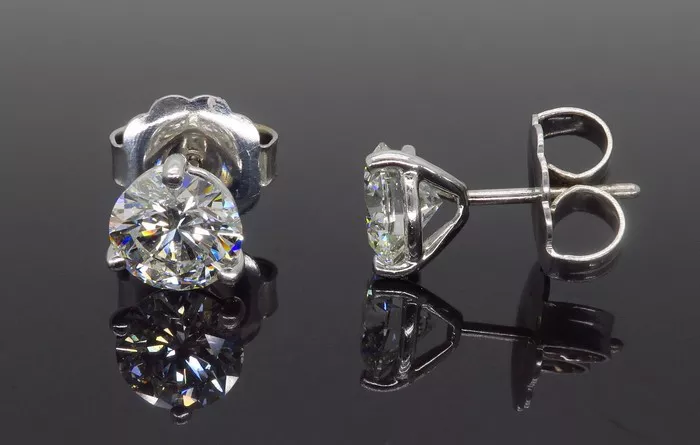When it comes to selecting diamond studs, size is one of the most significant factors to consider. Diamond studs are versatile pieces that can elevate any outfit, from casual wear to formal attire. However, determining the best size of diamond studs for everyday wear can be challenging. This article will guide you through the considerations involved in choosing the right size for your diamond studs.
Understanding Carat Weight
The size of a diamond is often measured in carats. One carat equals 200 milligrams. Carat weight directly influences a diamond’s size and appearance. However, it’s essential to note that carat weight does not equate to physical dimensions. Different diamonds with the same carat weight can have varying sizes due to their cut.
Recommended Sizes for Everyday Wear
For everyday wear, diamond stud sizes typically range from 0.25 carats to 1.5 carats per earring.
0.25 to 0.5 Carats: These smaller sizes are ideal for those who prefer a subtle, understated look. They are lightweight and comfortable, making them perfect for daily wear. They add just a hint of sparkle without being overwhelming.
0.5 to 1 Carat: This size range strikes a balance between elegance and practicality. A 1-carat diamond stud will catch the light beautifully without being too flashy. It is a popular choice for those who want a more noticeable diamond but still prioritize comfort.
1 to 1.5 Carats: These larger studs make a statement while still being suitable for everyday wear. They are perfect for those who love a bit of glamour in their daily style. However, they may feel heavier than smaller sizes, so it’s essential to ensure they are set securely.
Consider Your Personal Style
Your personal style plays a crucial role in determining the size of your diamond studs. Some people prefer a minimalist approach, opting for smaller, delicate pieces. Others might enjoy bolder accessories that make a statement. Think about your wardrobe and lifestyle.
If you wear a lot of casual or sporty outfits, smaller studs may complement your style better. On the other hand, if you frequently dress up or attend events, larger diamond studs might be more appropriate.
Face Shape and Size
Your face shape and size can influence how a diamond stud will look on you.
Round Faces: People with round faces may want to choose slightly larger studs. This can create balance and elongate the face.
Square Faces: For square faces, softer and smaller studs can help round out sharp angles.
Oval Faces: Oval faces can pull off almost any size. However, smaller studs can maintain the soft look of the face.
Heart-Shaped Faces: Those with heart-shaped faces should consider larger studs. This helps balance the proportions between the forehead and the chin.
Setting and Style Considerations
The setting of your diamond studs also affects their overall appearance. Popular settings include:
Prong Setting: This classic setting allows maximum light to enter the diamond, enhancing its sparkle. It works well for both small and large diamonds.
Bezel Setting: A bezel setting encircles the diamond with metal. This style can make the diamond appear larger and is more secure, making it great for everyday wear.
Halo Setting: A halo of smaller diamonds surrounds a central diamond. This style creates the illusion of a larger diamond and adds extra sparkle.
Choosing the right setting will impact how the size of the diamond appears. For example, a halo setting can make a smaller diamond look more substantial.
Quality Over Quantity
While size is essential, the quality of the diamond is equally important. The Four Cs—carat, cut, color, and clarity—determine the overall appearance of a diamond.
Cut: The cut significantly affects the diamond’s sparkle. A well-cut diamond will reflect light beautifully, regardless of its size.
Color: Diamonds come in a range of colors. The less color a diamond has, the more valuable it is. For everyday wear, consider diamonds in the G-H color range. They appear colorless but are more affordable than D-F color diamonds.
Clarity: Clarity refers to the presence of inclusions or blemishes in the diamond. For everyday wear, diamonds with a clarity grade of VS2-SI1 can be a good choice. They offer excellent value while still appearing flawless to the naked eye.
Comfort and Weight
Comfort is crucial for everyday wear. Heavier diamond studs can become uncomfortable over time. Consider the following:
Post Length: The length of the post can affect how the studs sit on your earlobe. A longer post may provide a more comfortable fit for larger studs.
Backing Type: Different types of backings can enhance comfort. Screw-back settings provide a secure fit, while push backs are easier to remove.
Choose a diamond stud size that feels comfortable and secure on your ears.
Occasion Versatility
When selecting diamond studs, consider how often you plan to wear them. Smaller sizes are versatile and suitable for various occasions. Larger sizes can be reserved for special events but can still be worn daily with the right outfit.
Budget Considerations
Your budget is another critical factor in selecting diamond studs. Generally, the price of a diamond increases with its size. However, you can find beautiful diamonds at various price points.
To maximize your budget, consider slightly smaller diamonds with higher quality in terms of cut and clarity. This approach will allow you to enjoy stunning diamond studs without overspending.
See also: Best Diamond Stud Size
Final Thoughts
When choosing the best size for everyday diamond studs, consider carat weight, personal style, face shape, and comfort. While larger diamonds make a statement, smaller studs offer elegance and versatility.
The right diamond studs can enhance your appearance and provide a sense of elegance in your daily life. Select the size and style that resonate with your personality and lifestyle, ensuring that your diamond studs remain a cherished part of your jewelry collection for years to come.
Investing in quality pieces will provide not only lasting beauty but also joy as you wear your diamonds every day.
Related topics:

